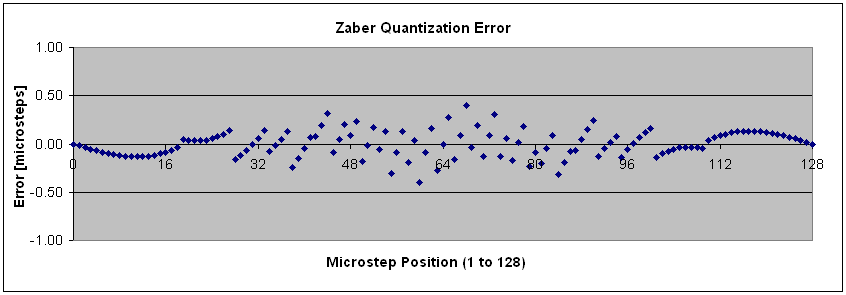Microstepping Tutorial
From ZaberWiki
Contents[hide] |
[edit] Microstepping Theory
A bipolar stepper motor has two windings. The current through each winding is varied in order to rotate the stepper motor. When considering stepper motor drive techniques, a "phase diagram" is a useful visualization tool. The current through one winding Ia is plotted against the current through the other winding Ib. Modes of operation such as full stepping, half stepping, microstepping, and operation at different current limits can be easily visualized on such a diagram. In addition, it is possible to visualize changes in both power consumption and torque as a function of angular position.
Simple stepper motor controllers are only capable of driving a winding with full positive current, no current, or full negative current. Given these available outputs it is only possible to implement full stepping, half stepping, or wave stepping.
The arrows in each phase diagram are called a "phasors". The angle theta that the phasor moves from one position to the next is the step or microstep angle. On a phase diagram, 90° corresponds to one full step and 360° corresponds to a "full step sequence". A full step sequence is a sequence of steps or microsteps which, when repeated, will produce continuous rotation of the motor. Assuming adequate torque, any continuous path which traverses the 4 quadrants of the phase diagram with at least one point per quadrant will suffice to rotate the stepper motor.
If the controller is designed with the capability to control the magnitude of the current in each winding, then microstepping can be implemented. The phase diagrams below all show different implementations of "divide by 4" microstepping. Note that it is the phasor angle (not it's length) that determines the microstep position. The phasor length affects power consumption and available torque as we will see later.
While it is convenient to think of the Ia and Ib
axes as representing full step positions, it should be recognized that
this is an arbitrary choice and any 4 positions in the phase diagram
that are 90° apart from each other could be considered full step
positions. However, for the sake of simplicity, let us consider the
positive Ia axis to represent theta = 0°. As theta
increases, the phasor moves counter-clockwise from this position. At
theta = 90° the phasor lies along the positive Ib axis, one
full step from it's starting position. Any angle theta between 0 and
90° represents a possible microstep position (a position between full
step positions). If you wish to implement "divide by 10" microstepping,
then you must generate values of Ia and Ib that correspond to values of
theta equal to 0, 9, 18, 27 ... 81, 90°, etc. Mathematically theta is
related to Ia and Ib by the formula:
theta = Tan-1(Ib/Ia)
There are many values of Ia and Ib that could be chosen to produce the same phasor angle theta. The choice of phasor length is typically decided based on the motor power rating and the application's torque requirements. Power and torque are both related to phasor length. The power draw at any given angular position is given by the formula:
power = Ia2R + Ib2R
where R is the winding resistance (both windings should have the same resistance)
The length of the phasor is given by the formula:
phasor_length = Sqrt(Ia2 + Ib2) = Sqrt(Power/R)
Thus the phasor length gives an indication of the power draw at each microstep angle. Torque is directly proportional to current (assuming magnetic saturation is not reached). Thus the available torque is directly proportional to phasor length, and the phase diagram gives an indication of how torque may vary with microstep position. Aside: note that phasor length is proportiaon to torque and to Sqrt(Power). Therefore torque is proportional to Sqrt(Power). In other words, a 2x increase in torque requires a 4x increase in power (assuming magnetic saturation is not reached).
A phasor of constant length is typically used for smoothest operation
(minimum torque ripple) and constant power output. This results in a
circular path around the phase diagram, the phasor length being the
radius of the circle. This technique is referred to as "sine cosine
microstepping" because the target values for Ib and Ia are proportional
to sin(theta) and cos(theta) respectively. In practice, the term
microstepping usually refers to sine cosine microstepping, but in
theory, sine cosine microstepping is only one method of microstepping.
As mentioned above, a functioning microstepping algorithm may be
designed around any arbitrary path which traverses the 4 quadrants of
the phase diagram and has at least one point per quadrant.
The maximum continuous power output of a motor is usually
specified by the manufacturer. This places an upper limit on phasor
length, sqrt(Ia2 + Ib2). The effective limit that this places on Ia and Ib will depend on the geometry of the path chosen around the phase diagram.
One must also consider the limitations of the power supply being used
to drive the motor. In voltage controlled products, the maximum values
of Ia and Ib may be limited by the power supply voltage (I=V/R). In
this case, using a square phase profile is a way to achieve higher
torque without requiring a higher voltage power supply.
In Zaber products, the user may select betwee square phase mode and
circular phase mode, in addition to specifying the current limit (the
value of Ia
at theta = 0). Square phase mode offers about 40% higher torque for the
same current limit. However there is a price to pay and that is torque
ripple. You can see that as you move around the phase diagram along a
square path, the torque (proportional to the length of the phasor) will
be constantly increasing and decreasing. This result in less smoothness
of operation and less microstepping accuracy. Generally it is easier to
achieve higher torque simply by increasing the current limit. However,
sometimes your maximum current limit is restricted by your supply
voltage, or the capabilities of your controller. In this case, reduced
smoothness and accuracy may be an acceptable compromise for additional
torque.
[edit] Sources of error in microstepping systems
Stepper motor control systems are usually open loop. That is the controller does not have position feedback and therefore is not aware of the "actual" position of the motor. Therefore it is important to be aware of possible sources of error that will result in the actual position being different from the calculated position.
[edit] Quantization Error
In any digital controller, it is impossible to achieve infinitely variable Ia and/or Ib. Only discrete or "quantized" values are possible. The number of discrete values depends on the resolution achievable by the controller. For example, if the maximum current output of the controller is 1A and the controller has a resolution of 0.1A then there are 10 possible current values for Ia and/or Ib not including 0. The number of discrete values possible determines how close mathematically the phasor can be set to a particular length and microstep angle. The error between the desired phasor angle and the actual phasor angle achieved is the quantization error. This is shown diagramatically below.
Image:Microstepping quantization error definition.png
A maximum quantization error equivalent to 0.5 microsteps is a typical design requirement in any microstepping control algorithm. Note that by adusting the phasor end point to a nearby Ia,Ib point rather than sticking to a strictly circular or square profile can often reduce the quantization error, but may add some torque ripple. Thus the current resolution you require for Ia and Ib will be determined by the number of microsteps per step you want to achieve, the quantization error you can tolerate, and the torque ripply you can tolerate.
In Zaber's stepper motor control algorithm our design requirements were 128 microsteps per step with a quantization error less than 0.5 microsteps and a torque ripple less than 2.5%. Determining how many discrete current values are required for Ia and Ib is a task best left to a spreadsheet application such as Excel. Even then it requires a certain degree of trial and error. As it turns out, 80 discrete current settings (between 0 and the running current) are required to achieve 128 microsteps per step with a quantization error less than 0.5 microsteps and a torque ripple less than 2.5%. The resulting quantization error at each microstep position is plotted below.

[edit] Detent Error
Detent torque is the maximum torque that can be applied to an unenergized stepper motor without causing continuous rotation. If you plotted torque vs shaft angle as you slowly rotate the stepper motor with no current in either winding, then you would find that the torque is approximately sinusoidal with shaft angle. The detent torque is just the amplitude of the sine curve. In an ideal motor, the torque curve would be perfectly sinusoidal. What is commonly referred to as "detent error" isn't due to the existence of the detent torque per se but due to the non-sinusoidal component of the detent torque. The shape of the torque curve is affected by motor pole geometry. In that sense, detent error is really pole geometry error. Because different motor manufacturers use different pole geometries, this error can vary from one manufacturer to another as well as from one motor to another.
[edit] Motor Pole placement error
Motor pole placement error results in a varying step size. There is typically an error that repeats every 4 steps (one complete step cycle), as well as an error that repeats every full revolution. This has an obvious effect on microstepping. The microstep size within large steps will be proportionally larger than the microstep size in small steps. Pole placement error in a typical motor is less than 0.5 steps of cumulative error over half a revolution of the motor. Given that a typical motor has 200 steps per revolution, that translates to an error in step size of roughly +/- 0.5%. It is possible to eliminate pole placement error in any application simply by moving in increments of one full revolution of the motor. If that is not possible, then some error can be eliminated by moving in increments of 4 steps. However, moving in increments of 4 steps or full revolutions is clearly not microstepping. Therefore, all microstepping applications invariably suffer from some pole placement error.
[edit] Leadscrew pitch error
Many motorized systems convert rotary motion to linear motion via leadscrew. Stepper motor applications are no exception. In these types of systems, any error in the leadscrew pitch will contribute to the total system error.
[edit] Sticktion and Backlash Error
In microstepping systems, mechanical sticktion and backlash are frequently much larger than the microstep resolution. There are many systems on the market capable of microstepping at 256 microsteps per step, but there is little point to this if mechanical sticktion in the system will be on on the order of 5 to 10 microsteps at that microstep resolution.
'하드웨어 > 로봇관련' 카테고리의 다른 글
| BLDC Motor 기술 (3) | 2006.04.19 |
|---|---|
| [본문스크랩] 청소로봇의 원리 (0) | 2006.03.22 |














